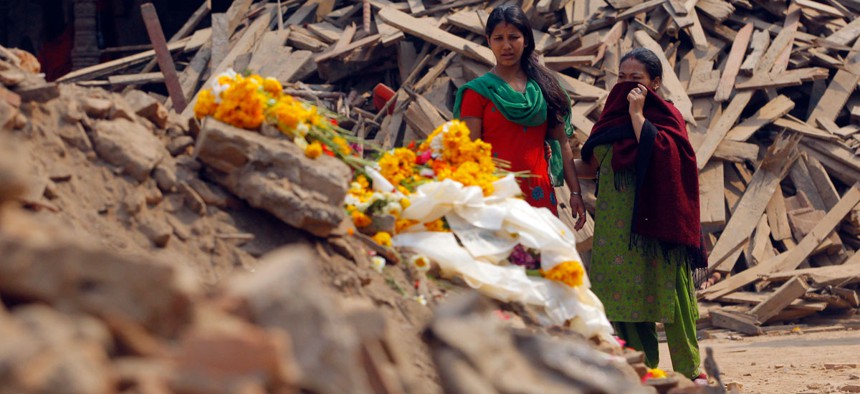NASA Technology Located Four Trapped Earthquake Victims in Nepal, by Detecting Their Heartbeats

Nepalese women look at floral tributes placed in memory of victims killed in last week's earthquake, at Basantapur Durbar Square in Kathmandu, Nepal. Niranjan Shrestha/AP
FINDER is a radar machine that sends a continuous microwave signal through the rubble, and can detect a human’s breathing or heartbeat (and distinguish it from the movement of an animal).
A technology developed by NASA and the US Department of Homeland Security designed to save people trapped by debris in natural disasters has been used in the field for the first time.
FINDER (Finding Individuals for Disaster and Emergency Response) lived up to its name, locating and saving four people trapped under rubble for days after the 7.8 earthquake in Nepal killed more than 7,000 people and injured countless others.
FINDER is a radar machine that sends a continuous microwave signal through the rubble, and can detect a human’s breathing or heartbeat (and distinguish it from the movement of an animal). It can locate people hidden behind 20 feet of solid concrete or buried beneath 30 feet of rubble, and the person doesn’t need to be conscious to be detected.
Gratified our #FINDER helped rescue 4 survivors from #NepalQuake rubble. @DHSgov joint effort http://t.co/XneMG308lI pic.twitter.com/sWvFDpVgXm
— NASA JPL (@NASAJPL) May 6, 2015“NASA technology plays many roles: driving exploration, protecting the lives of our astronauts and improving—even saving—the lives of people on Earth,” David Miller, NASA’s chief technologist, said in a press statement. “FINDER exemplifies how technology designed for space exploration has profound impacts to life on Earth.”
Many other NASA technologies have been used to help life here on Earth, like land mine removal techniques, firefighting gear, and water purification devices.
NASA is working to commercialize the FINDER technology in order to get it into the hands of more first responders. No doubt more earthquake victims could have been saved if FINDER was deployed with more search and rescue teams.





